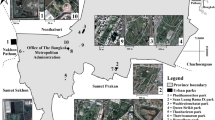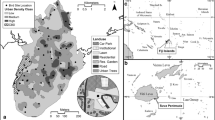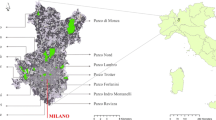Abstract
Given that rates of urbanization are rising globally, the need to maintain and enhance urban biodiversity has become important. This study examines the relative influence of different land-use types as well as environmental resources (trees, flowering trees, fruiting trees, shrubs, telecommunication mast, pylons, electric poles, buildings) on bird diversity indicators in a rapidly developing urban settlement in Ghana. Remote sensing was used to estimate the extent of conversion of natural habitats into urban settlements. Using point count surveys, bird species were recorded and compared in randomly selected plots of four land-use types of farmlands, remnant forest, residential and commercial areas. We further evaluated the relative influence of habitat resources on bird diversity indicators. We found a significant expansion of built-up areas into natural habitats in the study area. Also, there has been a significant increase in sparse vegetation coupled with a drop in the area covered by dense vegetation over the last three decades. Avifauna diversity indicators differ significantly across the four land-use types with urban farmlands being the most species diverse, followed by urban remnant forests, then residential and finally commercial areas. Our findings suggest that avian species diversity indicators decreased significantly with increasing land-use intensity and revealed that the study area still possesses significant conservation potentials for urban birds and by extension biological diversity as long as vegetation fragments are maintained within a sustained urban expansion framework. We propose increasing the quantity and complexity of the vegetation cover in residential areas by supporting citizens to establish private yards to increase the city’s green network.




Similar content being viewed by others
Code availability
The datasets generated during and/or analysed during the current study are not publicly available but are available from the corresponding author on reasonable request.
References
Agbosu LK (2000) Land law in Ghana: Contradiction between Anglo-American and customary conceptions of tenure and practices. University of Wisconsin, Madison
Asabere SB, Acheampong RA, Ashiagbor G, Beckers SC, Keck M, Erasmi S, Schanze J, Sauer D (2020) Urbanization, land use transformation and spatio-environmental impacts: Analyses of trends and implications in major metropolitan regions of Ghana. Land Use Policy 96:104707
Ashiagbor G, Amoako C, Asabere SB, Quaye-Ballard JA (2019) Landscape transformations in rapidly developing peri-urban areas of Accra, Ghana: Results of 30 years. Open Geosci 11(1):172–182
Boon E, Ahenkan A, Baduon BN (2009) An assessment of forest resources policy and management in Ghana. Proceedings of the 29th Annual Conference of the International Association for Impact Assessment, Accra, Ghana, 16–22
Borrow N, Demey R (2014) Birds of western Africa, Second edn. Christopher Helm
Bregman TP, Sekercioglu CH, Tobias JA (2014) Global patterns and predictors of bird species responses to forest fragmentation: implications for ecosystem function and conservation. Biol Conserv 169:372–383
Brewster CL, Beaupre SJ, Willson JD (2018) Habitat loss and local extinction: linking population declines of eastern collared lizards (Crotaphytus collaris) to habitat degradation in Ozark glades. J Herpetology 52(3):352–360
Callaghan CT, Liu G, Mitchell BA, Poore AGB, Rowley JJL (2021) Urbanization negatively impacts frog diversity at continental, regional, and local scales. Basic Appl Ecol 54:64–74
Chamberlain DE, Henry DAW, Reynolds C, Caprio E, Amar A (2019) The relationship between wealth and biodiversity: A test of the Luxury Effect on bird species richness in the developing world. Glob Change Biol 25(9):3045–3055
Chamberlain DE, Kibuule M, Skeen R, Pomeroy D (2017) Trends in bird species richness, abundance and biomass along a tropical urbanization gradient. Urban Ecosyst 20(3):629–638
Cheke RA, Tratalos JA (2007) Migration, patchiness, and population processes illustrated by two migrant pests. Bioscience 57(2):145–154
Clergeau P, Jokimaki J, Snep R (2006) Using hierarchical levels for urban ecology. Trends in Ecology and Evolution 21:660–661
de Lima RF, Dallimer M, Atkinson PW, Barlow J (2013) Biodiversity and land-use change: Understanding the complex responses of an endemic‐rich bird assemblage. Divers Distrib 19(4):411–422
Dearborn DC, Kark S (2010) Motivations for conserving urban biodiversity. Conserv Biol 24(2):432–440
Deikumah JP, Kudom AA(2010) Biodiversity status of urban remnant forests in Cape Coast, Ghana.Journal of Science and Technology (Ghana), 30(3)
Demeyrier V, Lambrechts MM, Perret P, Grégoire A (2016) Experimental demonstration of an ecological trap for a wild bird in a human-transformed environment. Anim Behav 118:181–190
Dri GF, Fontana CS, de Sales Dambros C (2021) Estimating the impacts of habitat loss induced by urbanization on bird local extinctions. Biol Conserv 256:109064
Fontana S, Sattler T, Bontadina F, Moretti M (2011) How to manage the urban green to improve bird diversity and community structure. Landsc Urban Plann 101(3):278–285
Ganaie TA, Jamal S, Ahmad WS (2020) Changing land use/land cover patterns and growing human population in Wular catchment of Kashmir Valley, India. GeoJournal, 1–18
Ghana Meteorological Agency (2021) Ghana Meteorological Agency’s Seasonal Forecast for the Northern Sector and Seasonal Forecast Update for Southern Sector of Ghana
Ghana Statistical Service (2021) Ghana Population and housing census, General report, Cape Coast municipality. Ghana Statistical Service, Accra, Ghana
Ghana Statistical Service (2013) 2010 population and housing census district analytical report, Cape Coast municipality
Guan J, Kirikkaleli D, Bibi A, Zhang W (2020) Natural resources rents nexus with financial development in the presence of globalization: is the “resource curse” exist or myth? Resour Policy 66:101641
Guenat S, Kunin WE, Dougill AJ, Dallimer M (2019) Effects of urbanisation and management practices on pollinators in tropical Africa. Journal of Applied Ecology, 56(1), 214–224.
Han D, Chan L, Zhu N (2007) Flood forecasting using support vector machines. J Hydroinformatics 9(4):267–276
Hawthorne W, Lawrence A(2013) Plant identification: creating user-friendly field guides for biodiversity management. Routledge
Hof C, Araújo MB, Jetz W, Rahbek C (2011) Additive threats from pathogens, climate, and land-use change for global amphibian diversity. Nature 480(7378):516–519
Hope D, Gries C, Zhu W, Fagan WF, Redman CL, Grimm NB, Nelson AL, Martin C, Kinzig A(2008) Socioeconomics drives urban plant diversity. Urban Ecology (pp. 339–347)
Jakobsson S, Lindborg R (2017) The importance of trees for woody pasture bird diversity and effects of the European Union’s tree density policy. J Appl Ecol 54(6):1638–1647
Kebrle D, Zasadil P, Hošek J, Barták V, Šťastný K (2021) Large trees as a key factor for bird diversity in spruce-dominated production forests: Implications for conservation management. For Ecol Manag 496:119460
Lepczyk CA, La Sorte FA, Aronson MFJ, Goddard MA, MacGregor-Fors I, Nilon CH, Warren PS(2017) Global patterns and drivers of urban bird diversity. In Ecology and conservation of birds in urban environments (pp. 13–33)
Leveau LM (2019) Urbanization induces bird color homogenization. Landsc Urban Plann 192:103645
Leveau LM (2021) Big cities with small green areas hold a lower species richness and proportion of migrant birds: A global analysis. Urban Forestry and Urban Greening 57:126953
Leveau LM, Jokimäki J, Kaisanlahti-Jokimäki ML (2021) Urbanization buffers seasonal change in composition of bird communities: A multi-continental meta-analysis. J Biogeogr 48(10):2391–2401
Leveau LM, Leveau CM (2012) The role of urbanization and seasonality on the temporal variability of bird communities. Landsc Urban Plann 106(3):271–276
Leveau LM, Leveau CM (2016) Does urbanization affect the seasonal dynamics of bird communities in urban parks? Urban Ecosyst 19(2):631–647
Lowry H, Lill A, Wong BBM (2013) Behavioural responses of wildlife to urban environments. Biol Rev 88(3):537–549
MacGregor-Fors I (2008) Relation between habitat attributes and bird richness in a western Mexico suburb. Landsc Urban Plann 84(1):92–98
MacGregor-Fors I, Morales-Pérez L, Quesada J, Schondube JE (2010) Relationship between the presence of House Sparrows (Passer domesticus) and Neotropical bird community structure and diversity. Biol Invasions 12(1):87–96
Manu SA (2003) Effects of habitat fragmentation on the distribution of forest birds in South Western Nigeria with particular reference to Ibadan Malimbe and other malimbes. University of Oxford
Mason CF (2000) Thrushes are now largely restricted to the built environment in eastern England. Divers Distrib 6(4):189–194
Melles S, Glenn S, Martin K(2003) Urban bird diversity and landscape complexity: species-environment associations along a multiscale habitat gradient.Conservation Ecology, 7(1)
Mersha S, Gebremariam E, Gebretsadik D(2021) Drivers of informal land transformation: a perspective from the peri-urban area of Addis Ababa. GeoJournal, 1–14
Millard J, Outhwaite CL, Kinnersley R, Freeman R, Gregory RD, Adedoja O, Gavini S, Kioko E, Kuhlmann M, Ollerton J (2021) Global effects of land-use intensity on local pollinator biodiversity. Nat Commun 12(1):1–11
Morante-Filho JC, Faria D, Mariano-Neto E, Rhodes J(2015) Birds in anthropogenic landscapes: the responses of ecological groups to forest loss in the Brazilian Atlantic Forest.PLoS One, 10(6)
Newbold T, Scharlemann JPW, Butchart SHM, Şekercioğlu ÇH, Alkemade R, Booth H, Purves DW(2013) Ecological traits affect the response of tropical forest bird species to land-use intensity. Proceedings of the Royal Society B: Biological Sciences, 280(1750), 20122131
Oksanen J, Kindt R, Legendre P, O’Hara B, Stevens MHH, Oksanen MJ et al (2007) The vegan package. Community Ecol Package 10(631–637):719
Pérez-Hernández J, Gavilán RG(2021) Impacts of Land-Use Changes on Vegetation and Ecosystem Functioning: Old-Field Secondary Succession. Plants 2021, 10, 990
Piano E, Souffreau C, Merckx T, Baardsen LF, Backeljau T, Bonte D, Brans KI, Cours M, Dahirel M, Debortoli N (2020) Urbanization drives cross-taxon declines in abundance and diversity at multiple spatial scales. Glob Change Biol 26(3):1196–1211
R Core Team (2022) A Language and Environment for Statistical Computing, R Foundation for Statistical Computing, Vienna Austria. https://www.r-project.org/
Ramankutty N, Foley JA, Hall FG, Collatz GJ, Meeson BW, Los SO, De Brown E, Landis DR (2010) ISLSCP II potential natural vegetation cover. ORNL DAAC
Rico-Silva JF, Cruz-Trujillo EJ, Colorado ZGJ (2021) Influence of environmental factors on bird diversity in greenspaces in an Amazonian city. Urban Ecosyst 24(2):365–374
Rodrigues AG, Borges-Martins M, Zilio F(2018) Bird diversity in an urban ecosystem: the role of local habitats in understanding the effects of urbanization.Iheringia. Série Zoologia,108
Schwarz N, Moretti M, Bugalho MN, Davies ZG, Haase D, Hack J, Hof A, Melero Y, Pett TJ, Knapp S (2017) Understanding biodiversity-ecosystem service relationships in urban areas: A comprehensive literature review. Ecosyst Serv 27:161–171
Shea K, Roxburgh SH, Rauschert ESJ (2004) Moving from pattern to process: coexistence mechanisms under intermediate disturbance regimes. Ecol Lett 7(6):491–508
Solecka I, Sylla M, Świąder M(2017) Urban sprawl impact on farmland conversion in a suburban area of Wroclaw, Poland. IOP Conference Series: Materials Science and Engineering, 245(7), 72002
Stratford JA, Robinson WD (2005) Distribution of neotropical migratory bird species across an urbanizing landscape. Urban Ecosyst 8(1):59–77
Tratalos J, Fuller RA, Evans KL, Davies RG, Newson SE, Greenwood JJD, Gaston KJ (2007) Bird densities are associated with household densities. Glob Change Biol 13(8):1685–1695
United Nations Department of Economics and Social Affairs; Population Division (2021) World Population Clock: 7.9 Billion People (2021) Worldometer. https://www.worldometers.info/world-population
Vasenev VI, Yaroslavtsev AM, Vasenev II, Demina SA, Dovltetyarova EA (2019) Land-use change in New Moscow: First outcomes after five years of urbanization. Geogr Environ Sustain 12(4):24–34
Wilkinson DM(1999) The disturbing history of intermediate disturbance.Oikos,145–147
Wu J (2014) Urban ecology and sustainability: The state-of-the-science and future directions. Landsc Urban Plann 125:209–221
Xu X, Xie Y, Qi K, Luo Z, Wang X (2018) Detecting the response of bird communities and biodiversity to habitat loss and fragmentation due to urbanization. Sci Total Environ 624:1561–1576
Acknowledgements
We are grateful to A.P. Leventis Ornithological Research Institute (APLORI), Jos, Nigeria, and the Department of Conservation Biology and Entomology, University of Cape Coast, Ghana for the financial support.
Author information
Authors and Affiliations
Corresponding author
Ethics declarations
Statements and declarations
The authors have no relevant financial or non-financial interests to disclose.
Conflicts of interest/Competing interests
The authors declare no competing interest.
Data transparency
The datasets generated during and/or analysed during the current study are not publicly available but are available from the corresponding author on reasonable request.
Consent for publication
The authors do consent to the publication of this work in the above Journal.
Additional information
Publisher’s Note
Springer Nature remains neutral with regard to jurisdictional claims in published maps and institutional affiliations.
Electronic supplementary material
Below is the link to the electronic supplementary material.
Appendices
Appendices
Rights and permissions
Springer Nature or its licensor holds exclusive rights to this article under a publishing agreement with the author(s) or other rightsholder(s); author self-archiving of the accepted manuscript version of this article is solely governed by the terms of such publishing agreement and applicable law.
About this article
Cite this article
Afrifa, J.K., Monney, K.A. & Deikumah, J.P. Effects of urban land-use types on avifauna assemblage in a rapidly developing urban settlement in Ghana. Urban Ecosyst 26, 67–79 (2023). https://doi.org/10.1007/s11252-022-01281-0
Accepted:
Published:
Issue Date:
DOI: https://doi.org/10.1007/s11252-022-01281-0





